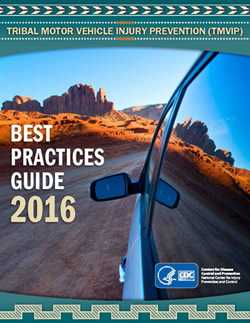Best Practices Guide
CDC’s Tribal Motor Vehicle Injury Prevention: Best Practices Guide 2016
The Tribal Motor Vehicle Injury Prevention (TMVIP) Best Practices Guide 2016 provides a summary of the burden of motor vehicle crash injury and death for the American Indian/Alaska Native (AI/AN) community. It offers recommended strategies with examples from Indian Country to increase seat belt use, increase child safety seat use, and reduce alcohol-impaired driving. The Guide also outlines five important components for TMVIP:
- Commitment
- Collaboration
- Data and Evaluation
- Tailored Evidence-Based Strategies
- Technical Support
Within each component, the Guide covers what is needed, lessons learned, case examples, resources, and calls to action for TMVIP programs.
- Page last reviewed: November 16, 2016
- Page last updated: November 16, 2016
- Content source:
- Centers for Disease Control and Prevention,
- National Center for Injury Prevention and Control,
- Division of Unintentional Injury Prevention


 ShareCompartir
ShareCompartir

